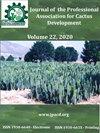不同磷浓度下仙人掌品种的农艺和矿质特征
IF 0.4
4区 农林科学
Q4 HORTICULTURE
Journal of the Professional Association for Cactus Development
Pub Date : 2023-06-30
DOI:10.56890/jpacd.v25i.455
引用次数: 0
摘要
饲料仙人掌在动物饲料中脱颖而出,因为它适应半干旱地区的气候条件,水分含量高,对用这种饲料植物喂养的动物有益。本研究的目的是评估不同饲料仙人掌品种在磷肥管理下的农艺和矿物特性。使用随机区块设计,在空间中具有分割地块,地块为饲料仙人掌品种(Giant sweet clone(Nopalea cochenillifera(L.)Mill.),小甜克隆(Nopalea cochenillifera(L.)Mill)和墨西哥(Opuntia tuna(L.)Mill))和亚群的磷剂量(0、30、60和90 kg P ha-1年),重复四次。评估和切割是在种植两年后进行的。将数据进行方差分析,显著性水平为5%。在饲料仙人掌梨品种间的平均比较中,采用了Tukey试验。使用软件SISVAR进行统计分析。品种Mexicana表现出较高的周长、宽度和单株绿色质量值。巨甜无性系获得了较高的厚度和长度值。小甜无性系的分枝数最多,长度、周长和宽度最短。关于品种小甜无性系,观察到矿物质、钙、锌和锰含量与磷和铁含量的二次响应,与磷剂量的增加有关。墨西哥和巨甜无性系品种在磷对钙、铁、锌和锰含量的剂量方面表现出二次响应。磷肥促进了仙人掌梨品种农艺性状的重要变化,特别是在分枝和产量的增加方面。仙人掌梨的矿物质受磷肥用量和植物基因型差异的影响。本文章由计算机程序翻译,如有差异,请以英文原文为准。
Agronomic and mineral characterization of cactus varieties under different doses of phosphorus
The forage cactus stands out in animal feed, as it adapts to the climatic conditions of the semi-arid region and has a high-water content with benefits for animals fed with this forage plant. The objective of this study was to evaluate the agronomic and mineral characteristics of different forage cactus varieties managed under phosphate fertilization. A randomized blocks design was used, with split-plots in the space, the plots being the forage cactus varieties (Giant sweet clone (Nopalea cochenillifera (L.) Mill.), Little sweet clone (Nopalea cochenillifera (L.) Mill) and Mexicana (Opuntia tuna (L.) Mill)) and the subplots the doses of phosphorus (0, 30, 60 and 90 kg P ha-1 year), with four repetitions. The evaluations and cuts were performed two years after planting. The data were submitted to analysis of variance with significance level of 5%. In the mean comparison between the forage cactus pear varieties, the Tukey’s test was used. Statistical analyzes were performed using the software SISVAR. The variety Mexicana presented higher values of perimeter, width, and green mass per plant. The variety Giant sweet clone obtained higher values of thickness and length. The highest number of cladodes and the shortest length, perimeter and width were observed on the variety Little sweet clone. Regarding the variety Little sweet clone, a quadratic response was observed for the mineral matter, calcium, zinc and manganese contents and linear response for phosphorus and iron contents, in relation to the increase of phosphorus doses. Mexicana and Giant sweet clone varieties presented quadratic response in the doses of phosphorus for calcium, iron, zinc, and manganese contents. Phosphate fertilization promotes important changes in the agronomic characteristics of the cactus pear varieties, especially in the increase of cladodes and yield. The minerals of the cactus pear are affected by the dosage of the phosphate fertilizer and by the genotypic difference of the plant.
求助全文
通过发布文献求助,成功后即可免费获取论文全文。
去求助
来源期刊

Journal of the Professional Association for Cactus Development
Agricultural and Biological Sciences-Plant Science
CiteScore
1.10
自引率
33.30%
发文量
10
期刊介绍:
The editors of the Journal of the Professional Association for Cactus Development, are very excited to be a part of the excellent editorial committee and to work together to create the synergism between scientists, growers, legislators, and business people so vital to the development of this industry to serve the people of arid lands.
 求助内容:
求助内容: 应助结果提醒方式:
应助结果提醒方式:


